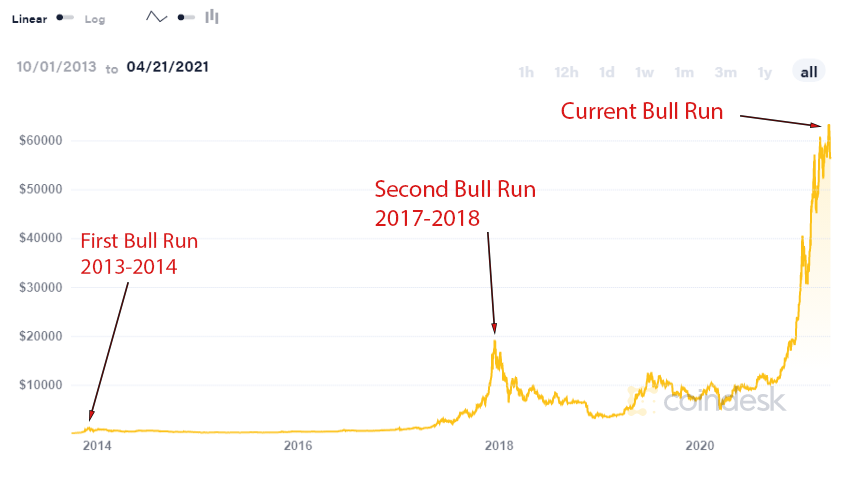It’s the question of the moment: Are cryptocurrencies in a bubble?
Prices for so many crypto projects have run up by jealousy-inspiring amounts. I own several that are up 200% to nearly 2,000% in less than a year. (And this includes the flash-crash that happened last weekend.)
Big numbers, no doubt. So, a question like “Are cryptocurrencies in a bubble” is understandable.
Truthfully, I don’t think crypto has hit bubble territory yet. We’re still early in the game.
While I’m rarely one to say “this time is different,” the crypto market is very much different than the last two times it skyrocketed in 2013 and 2017. I have a hunch this bull market is going to last longer, and run substantially higher, than most of the crypto fanboys presume because of what their models tell them.
See, those models are predicated on movements in bitcoin during those previous two bull markets. That’s not a bad starting point, but that’s all it is: a starting point. The models fail to reflect one monstrous, glaring anomaly this go ‘round.
Acceptance.
Who were the buyers in the last two bull markets? Techie crypto-geeks and early adopters like me.
Those two groups are still in the game—frankly, well ahead of the game. But now we have three new players: Wall Street, Corporate America, and Main Street. That trio far outnumbers the crypto-geeks and early adopters, and cumulatively they have a far-deeper wallet to draw upon.
And therein lies the huge, model-altering anomaly.
Today’s new buyers are not paying attention to the same buy/sell signals that crypto fan-boys geek out over. They don’t know those signals exist. They don’t care those signals exist.
They care about one fact: Crypto has moved into acceptance mode. It has passed the tipping point. They now see what so many of us early adopters recognized years ago: that the blockchain—the digital, immutable ledger on which all crypto runs—100% will change (and is already changing) the way the world operates.
As such, these new buyers are making up for lost time. They’re buying hand over fist.

Wall Street is stumbling over itself to jump onto the crypto bandwagon. Corporate America is rushing out a rash of crypto services. PayPal not only sells crypto now, it allows folks to pay for purchases with crypto.
Visa, meanwhile, has completed the first test in which it used the Ethereum network to process a credit card payment. It will roll that out to some 60 million global merchants very soon. Moreover, the credit card giant is working on a project that will soon allow Main Street banks to offer crypto investing and storage services to mom-and-pop customers who don’t want the hassle or the learning curve of dealing with a brokerage firm or dedicated crypto exchange.
These are game-changing moments, and they are why the crypto bull market will run longer than anticipated. (And, yes, along the way there will be more flash-crashes and retracements that will freak out the weak-willed. So you gotta have “diamond hands” to hold on tight in those moments.)
Honestly, I’m not sure it’s fair to define what’s going on right now in Wall Street terms of bull and bear markets. We have stepped through Alice’s looking glass and now exist in a new reality. The past is not necessarily a lesson in how we should view and react to the present.
We are in the midst of a fundamental, structural shift to banking, money, and credit.
Consumers, savers, investors, Wall Street, Main Street, and Corporate America are all now saying they like what the blockchain represents, which is why they’re increasingly sticking their money there.
Why did consumers gravitate to Amazon while Sears died and Barnes & Noble floundered? Why did the iPhone destroy the landline phone? Why did Netflix kill Blockbuster?
Efficiency. Cost savings. Selection. Options. Convenience.
Crypto is equally transformative.
It’s a new paradigm.
Buyers of crypto today want to own the infrastructure that will power tomorrow. To be clear, I am not talking specifically about bitcoin, but about scores of projects serving everything from supply-chain management to lending.
The naysayers are looking at crypto prices and screaming “Overvalued!” Twenty years ago, they screamed the same about Amazon when it was $80.
Today, Amazon is in the $3,400 range because it resonated with consumers and fundamentally changed the game of retail.
The savvy investors today are looking at individual crypto projects and they’re not asking, “Is it overvalued?” They’re asking a fundamental utility question: “Does this project address a need?”
Many of those projects have risen sharply already, but they will rise 10x, 20x, 50x from here. Some will increase 100x. Some 1,000x.
Question: If you could go back to 1999 and invest in Amazon at $80-plus per share—even as the dolts were screaming “OVERVALUED!”—would you?
By the end of this decade, people will be wishing they could return to 2021 and grab bitcoin, Ethereum, VeChain, Polkadot, Cardano, Chainlink, Polygon, Band Protocol, Ocean Protocol, Aave, Decentraland, Enjin, and so many others.
Note: Those are not necessarily recommendations. I just want to illustrate this column with projects that you can look up yourself to understand what they do and see why they’re going to change our world. I’ll be bringing you my personal crypto recommendations in the weeks ahead.
So, don’t wonder if crypto is in a bubble. Wonder, instead, where crypto is going—where the blockchain is going—and how it will change our lives. When you look at it that way, you see that the bigger risk isn’t valuation.
The biggest risk at this point is not owning crypto, regardless of valuation.

